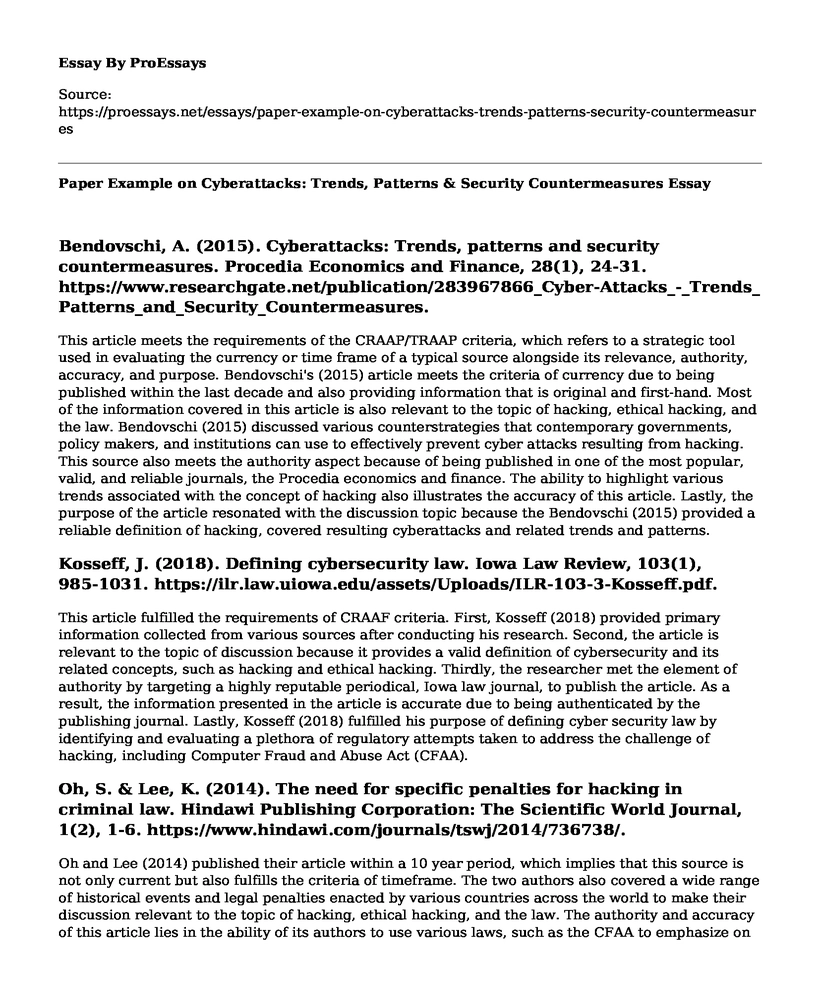Bendovschi, A. (2015). Cyberattacks: Trends, patterns and security countermeasures. Procedia Economics and Finance, 28(1), 24-31. https://www.researchgate.net/publication/283967866_Cyber-Attacks_-_Trends_Patterns_and_Security_Countermeasures.
This article meets the requirements of the CRAAP/TRAAP criteria, which refers to a strategic tool used in evaluating the currency or time frame of a typical source alongside its relevance, authority, accuracy, and purpose. Bendovschi's (2015) article meets the criteria of currency due to being published within the last decade and also providing information that is original and first-hand. Most of the information covered in this article is also relevant to the topic of hacking, ethical hacking, and the law. Bendovschi (2015) discussed various counterstrategies that contemporary governments, policy makers, and institutions can use to effectively prevent cyber attacks resulting from hacking. This source also meets the authority aspect because of being published in one of the most popular, valid, and reliable journals, the Procedia economics and finance. The ability to highlight various trends associated with the concept of hacking also illustrates the accuracy of this article. Lastly, the purpose of the article resonated with the discussion topic because the Bendovschi (2015) provided a reliable definition of hacking, covered resulting cyberattacks and related trends and patterns.
Kosseff, J. (2018). Defining cybersecurity law. Iowa Law Review, 103(1), 985-1031. https://ilr.law.uiowa.edu/assets/Uploads/ILR-103-3-Kosseff.pdf.
This article fulfilled the requirements of CRAAF criteria. First, Kosseff (2018) provided primary information collected from various sources after conducting his research. Second, the article is relevant to the topic of discussion because it provides a valid definition of cybersecurity and its related concepts, such as hacking and ethical hacking. Thirdly, the researcher met the element of authority by targeting a highly reputable periodical, Iowa law journal, to publish the article. As a result, the information presented in the article is accurate due to being authenticated by the publishing journal. Lastly, Kosseff (2018) fulfilled his purpose of defining cyber security law by identifying and evaluating a plethora of regulatory attempts taken to address the challenge of hacking, including Computer Fraud and Abuse Act (CFAA).
Oh, S. & Lee, K. (2014). The need for specific penalties for hacking in criminal law. Hindawi Publishing Corporation: The Scientific World Journal, 1(2), 1-6. https://www.hindawi.com/journals/tswj/2014/736738/.
Oh and Lee (2014) published their article within a 10 year period, which implies that this source is not only current but also fulfills the criteria of timeframe. The two authors also covered a wide range of historical events and legal penalties enacted by various countries across the world to make their discussion relevant to the topic of hacking, ethical hacking, and the law. The authority and accuracy of this article lies in the ability of its authors to use various laws, such as the CFAA to emphasize on the efforts taken by the United States in leading the fight against hacking and related activities such as malicious code. Also, the use of relevant statics, such as application of CFAA in court case from 2002 to 2012, presented through graphs increased the accuracy of this article. Therefore, Oh and Lee (2014) successfully fulfilled their purpose of emphasizing on the need to introduce penalties for hacking in criminal law by using examples of the United States, China, and Germany.
Pavlik, K. (2017). Cybercrime, hacking, and legislation. Journal of Cybersecurity Research, 1(1), 13-16.
The ability of presenting first-hand information regarding the issue of cybercrime, hacking, and legislation indicates that Pavlik (2017) fulfilled the criteria of currency. The author also provided a comprehensive discussion of the concept of cybercrime and hacking before comprehensively covering several applicable legislations, such as CFAA. This approach emphasized on the relevance of the article. Pavlik's (2017) article met the criteria of authority and accuracy by publishing it in a highly reputable source, the journal of cybersecurity research. Lastly, the author fulfilled his purpose of uncovering critical information regarding cybersecurity, hacking, and legislation by detailing a wide range of steps taken to address the threats resulting from malicious code and exploitation.
Rad, T. S. (2015). The sword and the shield: Hacking tools as offensive weapons and defensive tools. Georgetown Journal of International Affairs, 16(1), 123-133. https://search.proquest.com/openview/462a929d5dfd0e59740dba4eb09a470c/1?pq-origsite=gscholar&cbl=25675.
Rad's (2015) article meets the currency and timeframe criteria because it was published within the last decade and covers a plethora of events that historically transpired before its documentation. The article is also relevant to the field of hacking because it covers a wide range of related concepts and ideas. Rad's (2015) ability to use information gathered from various sources and the commitment by powerful security agencies, such as Department of Defense (DOD) and National Security Agency (NSA) also emphasizes on its authority and accuracy. The author also meets the element of accuracy by using multiple case studies, which highlight the efforts used by various countries and states across the world in developing cyber exploits to prevent the threat posed by cyber attacks. Lastly, the purpose of this article was to evaluate the significance of hacking tools not only as offensive but also defensive tools. Rad (2015) successfully met this goal by highlighting the diverse roles of the hacking tools, which changes according to the intentions of the user.
Cite this page
Paper Example on Cyberattacks: Trends, Patterns & Security Countermeasures. (2023, Apr 09). Retrieved from https://proessays.net/essays/paper-example-on-cyberattacks-trends-patterns-security-countermeasures
If you are the original author of this essay and no longer wish to have it published on the ProEssays website, please click below to request its removal:
- Cybersecurity Essay Sample: Case Study of Sony Entertainment Pictures
- Digitizing the Business Paper Example
- Essay Sample on Political Effects of Data Mining
- Understanding Agency & Ideology in Media Content Creation - Essay Sample
- Essay on Reflecting to Secure a Fulfilling Career: Utilizing Coursework Skills & Knowledge
- The Internet Revolution: Transforming Business Transactions Worldwide - Essay Sample
- Border Officials Can Search Your Phone - Essay Sample







